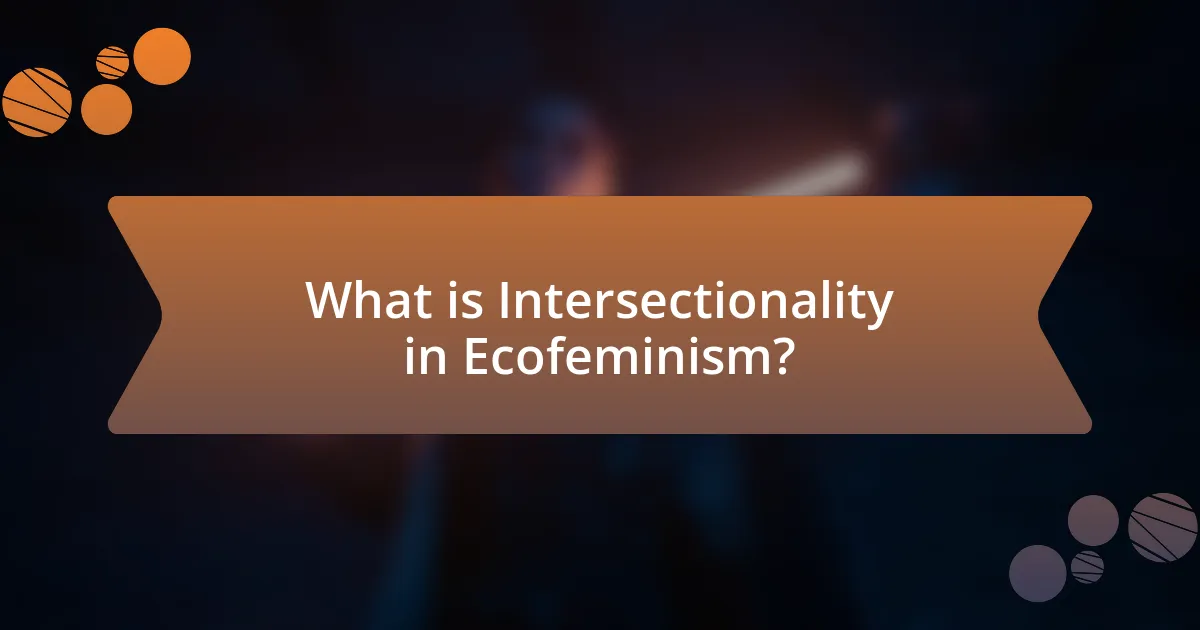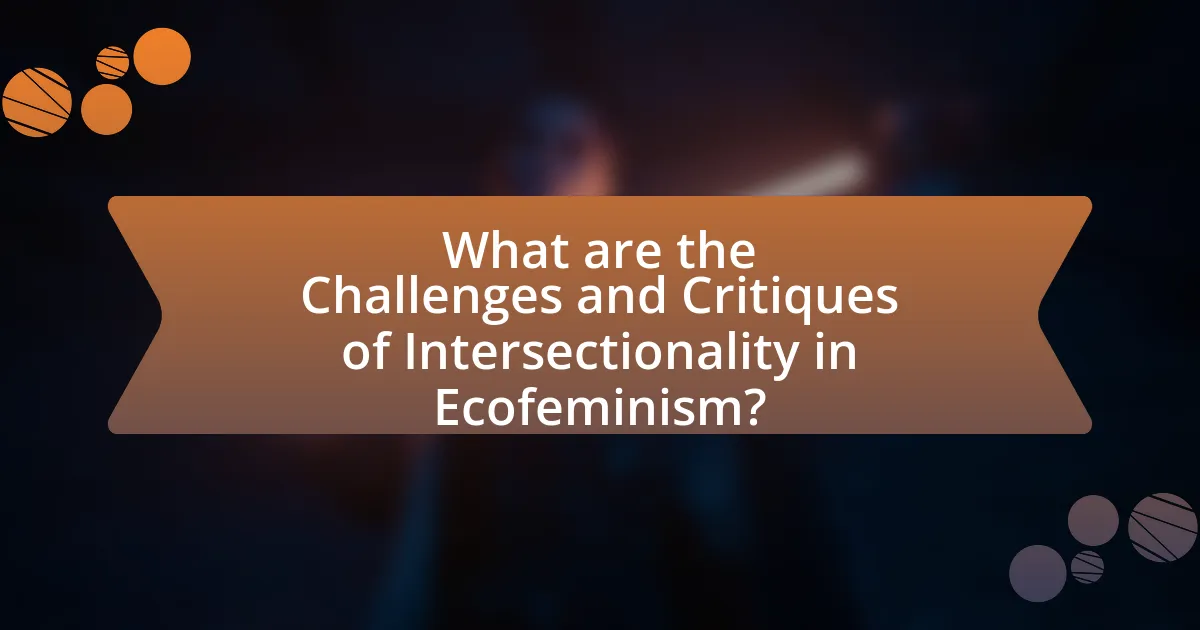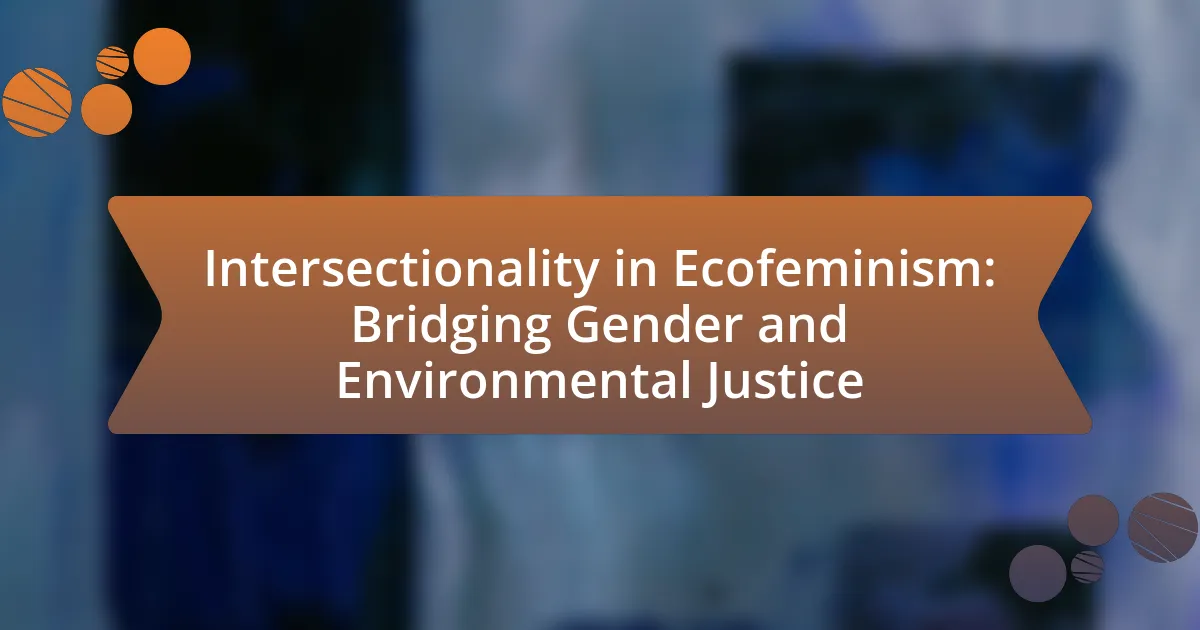Intersectionality in ecofeminism examines the interconnectedness of social categories such as gender, race, and class, and their impact on environmental issues. This framework reveals how marginalized groups, particularly women, experience unique forms of oppression related to environmental degradation. The article discusses how intersectionality enhances the understanding of ecofeminism by emphasizing the need for inclusive approaches that address both gender inequality and environmental justice. It also explores the historical contexts that shaped ecofeminism, the challenges and critiques of applying intersectionality, and practical steps for fostering inclusivity within ecofeminist movements. Overall, the article highlights the importance of recognizing diverse experiences in addressing systemic inequalities in environmental policies.

What is Intersectionality in Ecofeminism?
Intersectionality in ecofeminism refers to the interconnectedness of social categorizations such as gender, race, class, and environmental issues, highlighting how these overlapping identities contribute to unique experiences of oppression and privilege. This framework emphasizes that environmental degradation disproportionately affects marginalized groups, particularly women, and that addressing ecological issues requires an understanding of these intersecting social dynamics. For instance, studies show that women in developing countries often bear the brunt of environmental crises, as they are typically responsible for securing water and food, thus linking gender inequality directly to environmental justice.
How does intersectionality enhance our understanding of ecofeminism?
Intersectionality enhances our understanding of ecofeminism by highlighting the interconnectedness of various social identities and their impact on environmental issues. This framework reveals how factors such as race, class, gender, and sexuality intersect to shape individuals’ experiences with environmental degradation and resource access. For instance, Black women often face unique challenges related to both gender and racial discrimination, which can exacerbate their vulnerability to environmental harm, as evidenced by studies showing that marginalized communities are disproportionately affected by pollution and climate change. By incorporating intersectionality, ecofeminism becomes more inclusive and effective in addressing the diverse experiences of those impacted by environmental injustices, ultimately leading to more comprehensive solutions that consider the complexities of social inequalities.
What are the key principles of intersectionality in this context?
The key principles of intersectionality in the context of ecofeminism include the recognition of interconnected social identities, the understanding of how these identities shape experiences of oppression, and the emphasis on the interdependence of social justice and environmental justice. Intersectionality highlights that gender, race, class, and ecological factors are not isolated but rather intersecting systems that influence individuals’ experiences and access to resources. For instance, ecofeminism asserts that marginalized women often face compounded disadvantages due to both gender discrimination and environmental degradation, which can be seen in studies showing that women in developing countries disproportionately bear the burden of climate change impacts. This framework encourages a holistic approach to addressing both gender inequality and environmental issues, advocating for solutions that consider the complexities of these intersecting identities.
How does intersectionality relate to gender and environmental issues?
Intersectionality relates to gender and environmental issues by highlighting how various social identities, including gender, race, and class, intersect to shape individuals’ experiences with environmental degradation and resource access. For instance, women, particularly in marginalized communities, often bear the brunt of environmental crises due to their roles in resource management and their limited access to decision-making processes. Research by the United Nations Environment Programme indicates that women are disproportionately affected by climate change, as they represent a significant portion of the agricultural workforce in developing countries, making them vulnerable to shifts in climate patterns. This intersectional approach reveals that addressing environmental issues requires an understanding of the diverse impacts on different gender identities, thus promoting more equitable and effective environmental justice initiatives.
Why is ecofeminism important in addressing social justice?
Ecofeminism is important in addressing social justice because it highlights the interconnectedness of gender inequality and environmental degradation. This perspective emphasizes that the exploitation of women and nature stems from the same patriarchal structures, advocating for a holistic approach to social justice that includes both ecological and gender issues. Research by Vandana Shiva illustrates how women, particularly in developing countries, are disproportionately affected by environmental crises, reinforcing the need for policies that address both gender and environmental justice simultaneously. By integrating these issues, ecofeminism fosters a more equitable society that recognizes the rights of all marginalized groups.
What historical contexts have shaped ecofeminism?
Ecofeminism has been shaped by historical contexts such as the women’s liberation movement of the 1960s and 1970s, which highlighted the interconnectedness of gender oppression and environmental degradation. This movement brought attention to how patriarchal structures contribute to both the exploitation of women and the exploitation of nature. Additionally, the rise of environmentalism during the same period emphasized the need to address ecological issues, leading to a synthesis of feminist and ecological concerns. The publication of works like “The Death of Nature” by Carolyn Merchant in 1980 further solidified the link between ecological and feminist thought, arguing that the domination of women and nature stemmed from similar historical roots in Western philosophy. These contexts collectively underscore the importance of integrating gender and environmental justice in ecofeminist discourse.
How does ecofeminism challenge traditional environmentalism?
Ecofeminism challenges traditional environmentalism by integrating gender analysis into environmental issues, arguing that the exploitation of women and nature is interconnected. Traditional environmentalism often overlooks the social dimensions of environmental degradation, focusing primarily on ecological concerns without addressing the systemic inequalities that contribute to both environmental and gender injustices. Ecofeminists assert that patriarchal structures perpetuate both ecological harm and the oppression of women, as seen in the work of scholars like Vandana Shiva, who highlights how women’s roles in agriculture and resource management are often marginalized. This perspective emphasizes that true environmental justice cannot be achieved without addressing gender inequality, thus redefining the scope and approach of environmental activism.

How does Intersectionality Bridge Gender and Environmental Justice?
Intersectionality bridges gender and environmental justice by highlighting how overlapping social identities, such as race, class, and gender, influence individuals’ experiences with environmental issues. This framework reveals that marginalized groups, particularly women of color, often face disproportionate impacts from environmental degradation and climate change due to systemic inequalities. For instance, studies show that women in developing countries are more vulnerable to the effects of climate change, as they are often responsible for securing water and food resources, which are increasingly threatened by environmental changes. By addressing these interconnected injustices, intersectionality promotes a more inclusive approach to environmental justice that considers the unique challenges faced by diverse communities, thereby fostering equitable solutions that benefit all.
What role does gender play in environmental justice movements?
Gender plays a crucial role in environmental justice movements by influencing the experiences and perspectives of individuals affected by environmental degradation. Women, particularly in marginalized communities, often bear the brunt of environmental issues due to their roles in resource management and caregiving. Research indicates that women are more likely to be impacted by climate change and pollution, as they are typically responsible for water, food, and energy resources in many cultures. For instance, a study by the United Nations Development Programme highlights that women in developing countries are disproportionately affected by environmental changes, which exacerbates existing gender inequalities. This intersection of gender and environmental issues underscores the need for inclusive policies that address both environmental and social justice, ensuring that women’s voices and experiences are integral to the movement.
How do women’s experiences differ in environmental degradation?
Women’s experiences in environmental degradation differ significantly from men’s due to their unique social roles, economic status, and access to resources. Women often bear the brunt of environmental degradation, particularly in developing countries, where they are primarily responsible for securing water, food, and fuel for their families. For instance, when natural resources become scarce due to pollution or climate change, women face increased workloads and health risks, as they must travel further to obtain these essentials.
Research indicates that women are more vulnerable to the impacts of environmental degradation because they typically have less access to decision-making processes and resources that could mitigate these effects. A study by the United Nations Development Programme highlights that women’s limited access to land ownership and financial resources exacerbates their vulnerability in the face of environmental challenges. Furthermore, cultural norms often restrict women’s mobility and agency, making it harder for them to adapt to or recover from environmental crises.
In summary, women’s experiences of environmental degradation are shaped by their social and economic positions, leading to greater vulnerability and distinct challenges compared to men.
What are the implications of gendered perspectives on environmental policies?
Gendered perspectives on environmental policies significantly influence the effectiveness and inclusivity of these policies. By integrating gender analysis, policymakers can better understand how environmental issues disproportionately affect different genders, particularly women, who often bear the brunt of environmental degradation due to socio-economic inequalities. For instance, women in many developing countries are primarily responsible for water and food security, making them more vulnerable to climate change impacts. Research by the United Nations Development Programme highlights that gender-responsive policies can enhance resilience and adaptive capacity, ultimately leading to more sustainable environmental outcomes. Thus, incorporating gendered perspectives not only promotes social equity but also improves the overall efficacy of environmental policies.
How can intersectionality inform ecofeminist activism?
Intersectionality can inform ecofeminist activism by highlighting the interconnectedness of social identities and environmental issues, thereby fostering a more inclusive approach to activism. This framework recognizes that individuals experience oppression differently based on their race, gender, class, and other identities, which can influence their relationship with the environment. For instance, Black women often face both racial and gender discrimination, which can exacerbate their vulnerability to environmental degradation. Research by Crenshaw (1989) emphasizes that understanding these overlapping identities is crucial for addressing systemic inequalities. By integrating intersectionality, ecofeminist activism can better advocate for marginalized communities, ensuring that environmental justice efforts consider the diverse experiences and needs of all individuals affected by ecological issues.
What strategies can activists use to incorporate intersectionality?
Activists can incorporate intersectionality by adopting inclusive frameworks that recognize and address the interconnectedness of various social identities and systems of oppression. This can be achieved through strategies such as conducting intersectional analyses to understand how different identities—such as race, gender, class, and sexuality—interact and affect individuals’ experiences with environmental issues. For instance, the research by Crenshaw (1989) highlights how Black women face unique challenges that are not addressed by feminist or anti-racist movements alone. Additionally, activists can engage in coalition-building with diverse groups to amplify marginalized voices and ensure that their specific needs are represented in environmental policies. This approach not only fosters solidarity but also enhances the effectiveness of advocacy efforts by creating a more comprehensive understanding of the issues at hand.
How does intersectionality influence community-based environmental initiatives?
Intersectionality influences community-based environmental initiatives by highlighting the interconnectedness of social identities and systemic inequalities that affect marginalized groups. This framework allows for a more comprehensive understanding of how factors such as race, gender, class, and sexuality shape individuals’ experiences with environmental issues. For instance, research by Crenshaw (1989) emphasizes that women of color face unique environmental challenges that differ from those experienced by white women or men, necessitating tailored approaches in initiatives. By incorporating intersectionality, community-based environmental initiatives can address the specific needs and perspectives of diverse populations, leading to more equitable and effective outcomes.

What are the Challenges and Critiques of Intersectionality in Ecofeminism?
The challenges and critiques of intersectionality in ecofeminism include the difficulty of integrating diverse identities and experiences, which can lead to fragmentation within the movement. Critics argue that ecofeminism often prioritizes certain identities, such as race or class, over others, potentially marginalizing voices that do not fit neatly into these categories. Additionally, there is a concern that intersectionality may complicate the ecofeminist agenda, making it harder to achieve unified goals. For instance, some scholars highlight that the focus on multiple oppressions can dilute the urgency of environmental issues, as seen in debates surrounding climate justice, where economic and racial inequalities intersect with ecological concerns. These critiques emphasize the need for a more cohesive framework that effectively addresses the complexities of identity while maintaining a strong commitment to environmental justice.
What criticisms exist regarding the application of intersectionality in ecofeminism?
Criticisms regarding the application of intersectionality in ecofeminism include its potential oversimplification of complex identities and the risk of marginalizing certain voices within the movement. Scholars argue that intersectionality, while aiming to address multiple forms of oppression, can inadvertently prioritize certain identities over others, leading to a hierarchy of experiences. For instance, some critiques highlight that mainstream ecofeminism often centers the experiences of white, middle-class women, thereby neglecting the unique challenges faced by women of color and those from lower socioeconomic backgrounds. This can result in a lack of inclusivity and a failure to fully address the interconnectedness of gender, race, and environmental issues. Additionally, there are concerns that the theoretical framework of intersectionality may not always translate effectively into practical activism, limiting its impact on real-world environmental justice initiatives.
How do these critiques impact the effectiveness of ecofeminist movements?
Critiques of ecofeminism, particularly regarding its intersectionality, significantly impact the effectiveness of ecofeminist movements by highlighting the need for inclusivity and diverse perspectives. These critiques emphasize that traditional ecofeminism often overlooks the experiences of marginalized groups, such as women of color and lower socioeconomic classes, which can alienate potential allies and weaken collective action. For instance, a study by Crenshaw (1989) on intersectionality illustrates how overlapping social identities can compound discrimination, suggesting that ecofeminist movements must address these complexities to remain relevant and effective. By integrating diverse voices and experiences, ecofeminist movements can enhance their strategies and broaden their appeal, ultimately leading to more impactful environmental and social justice outcomes.
What are the potential pitfalls of intersectionality in activism?
The potential pitfalls of intersectionality in activism include the risk of fragmentation and the challenge of prioritizing issues. Fragmentation occurs when diverse groups focus solely on their specific identities, leading to a lack of solidarity and collaboration among movements. This can dilute collective efforts and weaken the overall impact of activism. Additionally, prioritizing issues can create tensions, as different groups may have conflicting needs or perspectives, making it difficult to address all concerns equitably. For instance, in ecofeminism, the intersection of gender and environmental justice may lead to debates over which issues should take precedence, potentially sidelining critical voices. These pitfalls highlight the complexities of navigating intersectionality in activism, necessitating careful consideration and inclusive dialogue to foster unity and effectiveness.
How can these challenges be addressed?
To address the challenges of intersectionality in ecofeminism, it is essential to implement inclusive policies that recognize the interconnectedness of gender and environmental issues. These policies should promote collaboration among diverse groups, ensuring that marginalized voices are heard in decision-making processes. Research indicates that inclusive environmental governance leads to more effective and equitable outcomes, as seen in the case of the United Nations’ Sustainable Development Goals, which emphasize the importance of gender equality and environmental sustainability. By integrating these perspectives, ecofeminism can effectively tackle the systemic inequalities that hinder both gender and environmental justice.
What best practices can enhance the application of intersectionality in ecofeminism?
Best practices that can enhance the application of intersectionality in ecofeminism include integrating diverse perspectives, fostering collaborative activism, and emphasizing local knowledge. Integrating diverse perspectives ensures that the voices of marginalized groups, such as women of color and indigenous communities, are included in environmental decision-making processes. Collaborative activism encourages partnerships between various social justice movements, recognizing the interconnectedness of gender, race, and environmental issues. Emphasizing local knowledge acknowledges the expertise of communities directly affected by environmental degradation, which can lead to more effective and culturally relevant solutions. These practices are supported by research indicating that inclusive approaches lead to more sustainable and equitable outcomes in environmental policies.
How can ecofeminists foster inclusivity and diversity in their movements?
Ecofeminists can foster inclusivity and diversity in their movements by actively incorporating intersectional perspectives that recognize the interconnectedness of gender, race, class, and environmental issues. This approach encourages collaboration with marginalized communities, ensuring that diverse voices are represented and heard in decision-making processes. Research indicates that movements that embrace intersectionality are more effective in addressing systemic inequalities, as they create a broader coalition of support and understanding. For instance, the work of scholars like Kimberlé Crenshaw highlights how intersectional frameworks can lead to more comprehensive strategies for social and environmental justice, ultimately enhancing the effectiveness of ecofeminist initiatives.
What practical steps can individuals take to support intersectionality in ecofeminism?
Individuals can support intersectionality in ecofeminism by actively engaging in advocacy that addresses both gender and environmental issues simultaneously. This can be achieved through participating in local environmental initiatives that prioritize marginalized voices, such as women and indigenous communities, ensuring their perspectives are included in decision-making processes. Additionally, individuals can educate themselves and others about the interconnectedness of social justice and environmental sustainability, promoting awareness of how systemic inequalities impact ecological degradation. Supporting organizations that focus on ecofeminist principles, such as those that work towards sustainable practices while empowering women, further reinforces this commitment. Research indicates that inclusive approaches in environmental policy lead to more effective and equitable outcomes, highlighting the importance of intersectionality in achieving comprehensive solutions.
